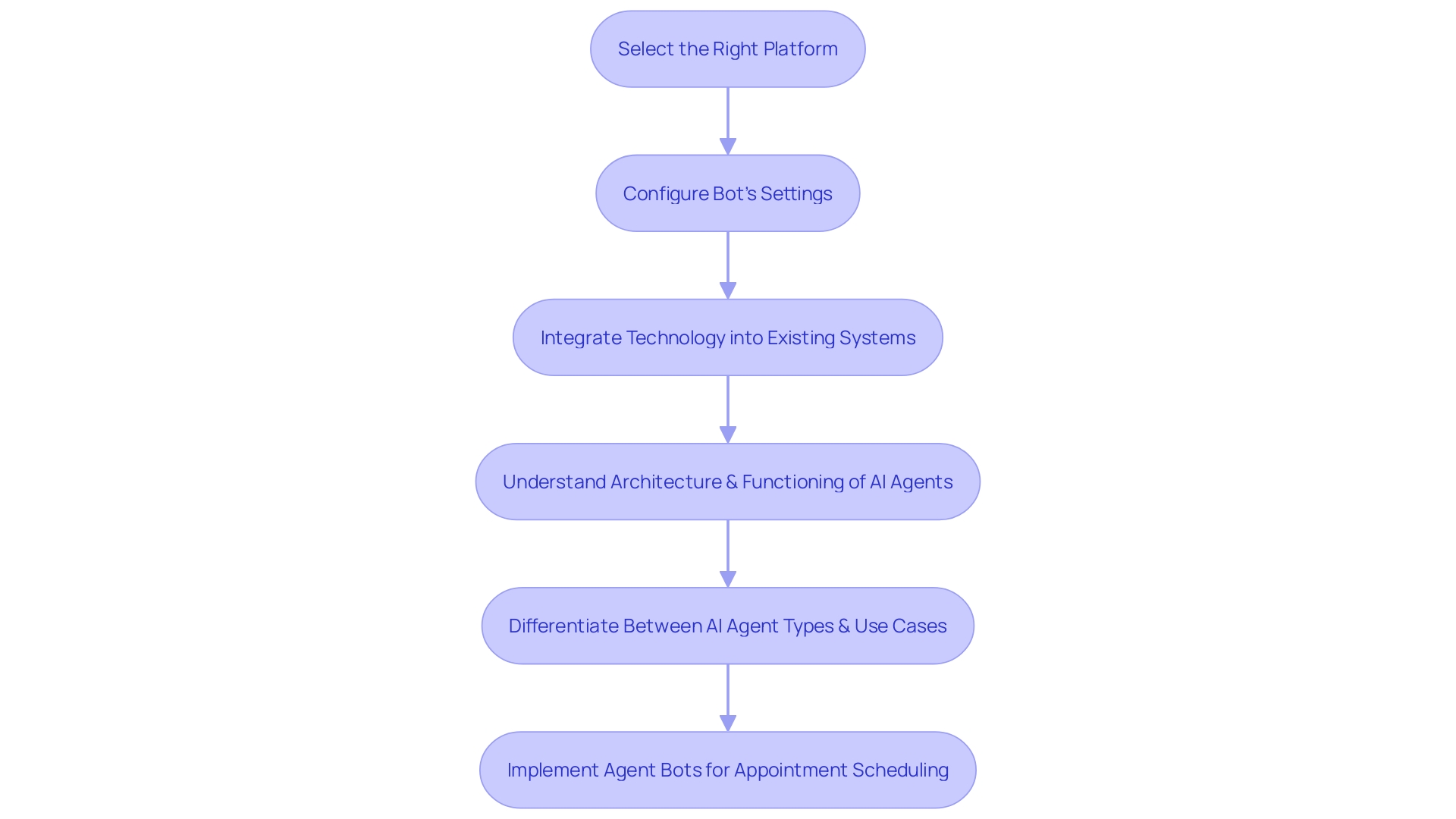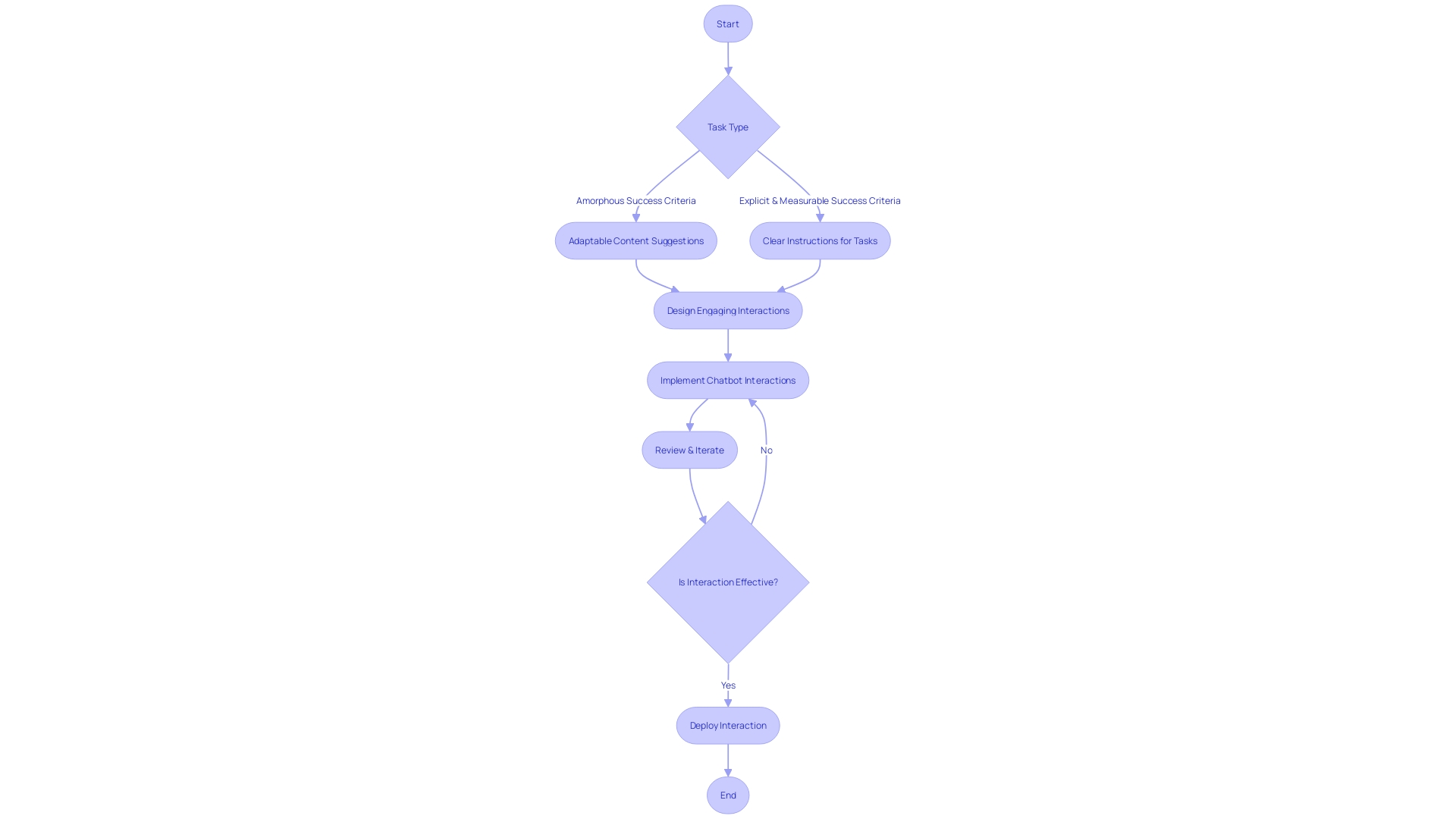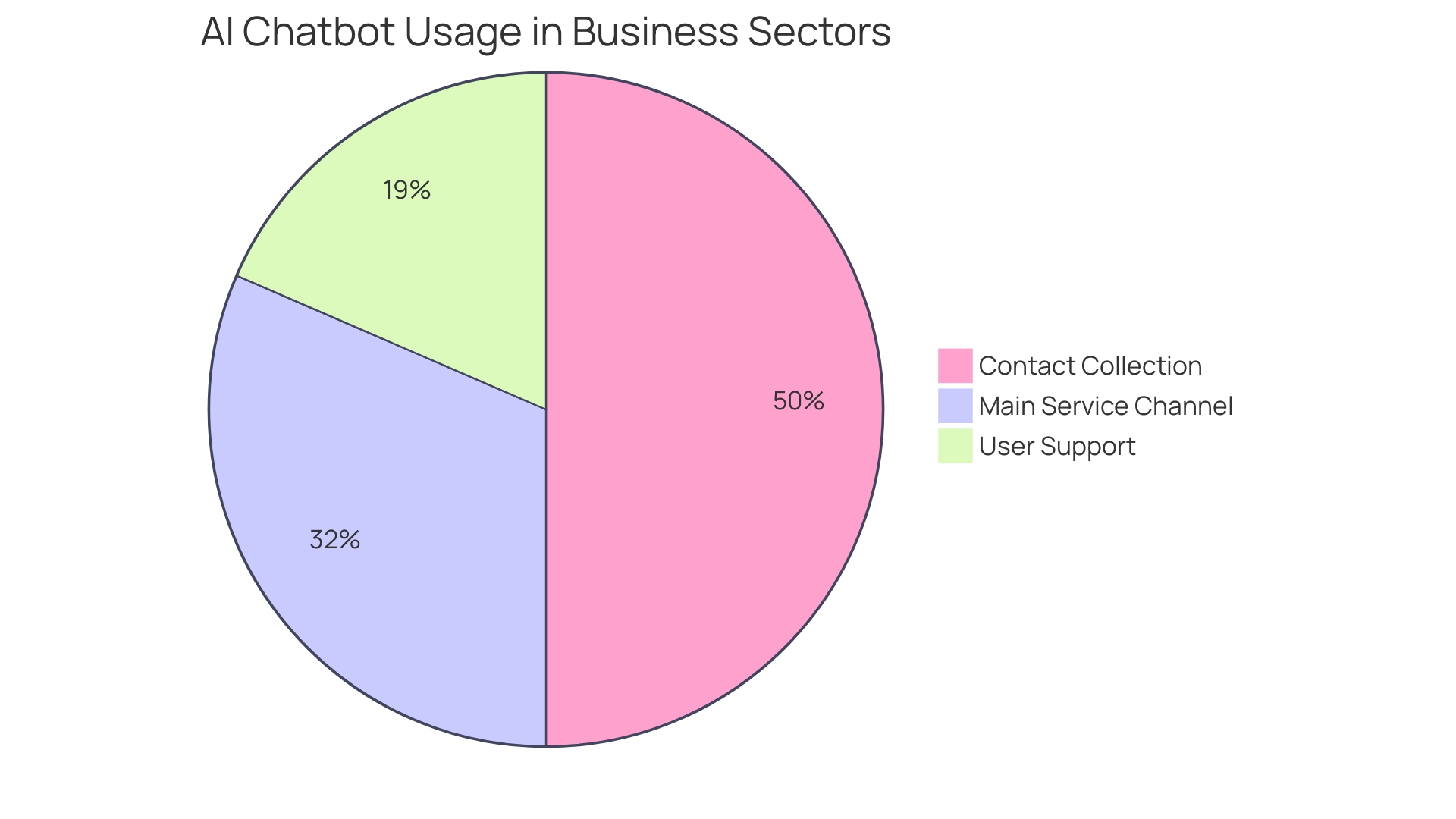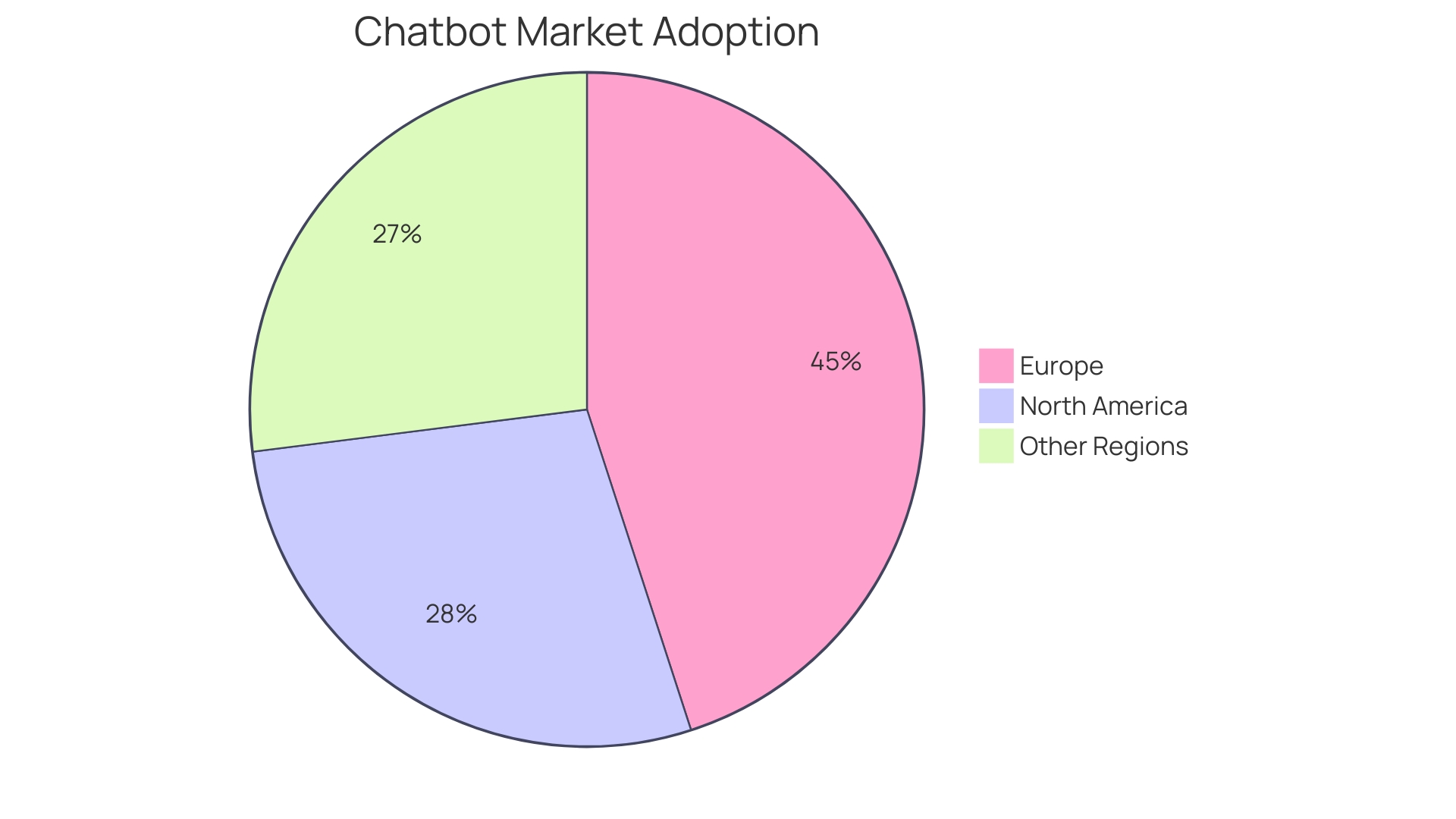Introduction
Implementing agent bots can revolutionize customer interaction, offering convenient and accessible solutions. However, setting up these intelligent agents requires careful consideration and strategic integration. From selecting the right platform to configuring the bot’s settings, every step plays a crucial role in ensuring a seamless customer service experience.
As we approach a future where chatbots may become the primary customer service channel, the need to adopt and adeptly set up these intelligent agents becomes increasingly evident. In this article, we will explore the practicality of bots, discuss effective agent bot interactions, delve into key principles for agent bot design, examine personalized agent bot experiences, highlight best practices for agent bot conversations, explore training and improvement strategies, and discuss monitoring and optimizing agent bot performance. Join us as we unpack the complexities of designing and implementing agent bots to enhance user interaction and elevate customer experience.
Setting Up Agent Bots
Implementing agent bots, like the transformation Benefit Cosmetics undertook for their appointment scheduling, can revolutionize interaction. Instead of a one-way communication through text messages, the beauty industry leader utilized the functionalities of WhatsApp, allowing individuals to conveniently view, modify, or cancel their appointments. This strategic move underscores the importance of selecting the right platform for bot integration, ensuring it aligns with customer preferences and enhances accessibility.
Once the platform is chosen, configuring the bot’s settings is the next vital step. It demands a nuanced method, similar to CurioAI’s personalized podcast production, to meet the needs of a wide range of individuals. By programming the bot with the ability to reason, plan, and take action based on user input, it becomes a 24/7 representative for your brand, equipped with expert-level knowledge and data access.
Integrating this technology into your existing systems is akin to adopting a new platform, reminiscent of the shift from operating systems like Android to more intelligent frameworks. Agents become an extension of your operations, capable of proactive measures such as adjusting pricing or launching campaigns, as highlighted by the potential ubiquity of agents in our daily lives.
To demonstrate the usefulness of bots, take into account the statistics indicating that 37% of chatbots not only collect contacts but also provide assistance. Placed strategically, such as on main or pricing pages, they can address FAQs and collect valuable lead qualification data. This duality of function streamlines communication and automates tasks, ultimately enhancing the service experience. As we near 2027, with forecasts of chatbots becoming the main customer service channel for a quarter of all businesses, the importance to embrace and skillfully establish these intelligent representatives becomes progressively clear.

Designing Effective Agent Bot Interactions
To create interactions with agent chatbots that are not only engaging but also efficient, we must consider different approaches for various scenarios. For tasks where success is amorphous—like seeking suggestions rather than definitive solutions—agent bots should provide content that individuals can adapt to their needs. For example, when a bot generates an email template, users typically customize it further. Success in these cases is less about solving a problem and more about providing valuable assistance.
Conversely, when success is explicit and measurable, such as instructing a person to carry out household tasks, the outcomes are clear. Some tasks have a single solution; for instance, when a command is given to switch on a light, there’s only one successful outcome. However, there are scenarios with multiple potential solutions, where various paths could lead to success or failure.
Taking inspiration from Devin, the world’s first fully autonomous AI software engineer, bots should strive for comparable capabilities. With advances in long-term reasoning and planning, Devin can execute complex tasks that involve thousands of decisions, while recalling context and learning over time. This shows the capability for automated assistants to not just follow instructions but also work together and provide suggestions that enhance interactions.
It’s crucial to acknowledge that bots are a new type of software, separate from traditional applications. They present unique challenges including latency, unreliability, and natural language interfaces, which necessitate innovative UI/UX paradigms. As we explore this new frontier of Human-Agent Interaction, it becomes clear that treating AI more like a human collaborator can enhance the way we engage with these systems.
In the realm of prompt engineering, the artistry lies in crafting prompts that are clear yet intricate enough to guide AI towards more nuanced and creative solutions. Techniques like self-refine prompting, where the AI refines its responses through an iterative process, are akin to an artist perfecting a sketch into a masterpiece. This method, in addition to considering the AI as a collaborator in conversation, can result in more individualized and advanced experiences.
As we explore this series on bot interactions, we’ll break down the intricacies of creating conversations that feel organic and conversational, while also customizing the experience to fulfill the unique requirements of individuals. We’ll use up-to-date examples and examine the fundamental principles that will influence the future of our interactions with AI.

Key Principles for Agent Bot Design
Developing a bot for improved interaction entails constructing a system that is both supportive and independent. These digital assistants are not mere tools; they are designed to reason, plan, and take actions based on user input or environmental conditions, akin to having an expert at your fingertips. For example, a service representative can offer 24/7 technical assistance, while a marketing representative can adjust to evolving business circumstances in real-time.
When designing an agent bot, simplicity, clarity, and consistency are paramount. The bot should provide intuitive interfaces that facilitate seamless navigation. Giving concise and instant feedback is crucial, as it not only informs individuals about the bot’s actions but also allows the bot to enhance its performance based on responses. In this manner, automated bots become more in tune with the specific requirements of individuals.
Complex multi-entity systems, where each individual possesses its own set of sensors and decision-making capabilities, show the breadth of applications, from traffic management to supply chain optimization. These systems rely on coordination through various techniques such as negotiation and cooperation.
In the context of LangChain, a leading open-source framework, developers are empowered to build applications with large language models. By chaining different components, developers can create sophisticated use cases, with differentiation arising from the correct application of these models. This highlights the necessity for domain expertise and a profound comprehension of customer needs to create exceptional experiences.
Incorporating these elements into agent bot design not only enhances interaction but also sets the stage for a transformative business operation. It’s through this careful design process that bots can truly meet the demands of individuals and deliver personalized, efficient service.

Creating Personalized Agent Bot Experiences
Tailoring interactions through AI-powered chatbots has become a cornerstone of engagement strategies. These digital entities, driven by advanced algorithms, are transforming customer service by delivering instant, round-the-clock replies to inquiries. Divergent from conventional software that necessitates manual operation, these autonomous entities independently gather insights from inputs and environmental conditions, empowering them to analyze, strategize, and execute to accomplish diverse objectives.
To create a truly personalized experience, these intelligent systems rely on the aggregation of user data, tapping into the wealth of knowledge and expertise of human counterparts. For example, in the field of technical support, an AI can provide expert-level assistance at any time, managing requests with the same proficiency as the most knowledgeable staff member. Similarly, marketing professionals can adapt to dynamic business conditions, akin to a self-driving car’s sensors, to proactively adjust strategies like pricing or campaign launches.
Research indicates that individuals increasingly perceive these conversational agents as social actors, integrating them into daily routines and building long-term relationships. This change highlights the necessity for businesses to utilize AI chatbots not only as tools but as part of a more extensive engagement platform.
Recent statistics further highlight the impact of chatbots, showing that all examined EdTech websites utilized chatbots for contact collection, with 37% providing additional user support. This trend is set to expand, with predictions that chatbots will become the main service channel for a quarter of all businesses by 2027. The advantages are evident: individuals appreciate decreased response times and customized support, while teams are relieved of repetitive tasks, enabling them to concentrate on more complex issues.
In a digital era where immediate and customized interaction is paramount, the development and deployment of AI chatbots are not just a trend but a transformative element in interaction, setting the stage for the next generation of customer experience platforms.

Best Practices for Agent Bot Conversations
Creating bot dialogues that resonate with individuals is crucial for any business aiming to remain competitive. By leveraging AI chatbots, companies can handle complex queries, maintain context throughout the interaction, and set clear expectations—all of which are crucial for a smooth user experience. For example, Holiday Extras, a European leader in travel extras, effectively utilizes ChatGPT Enterprise to assist their diverse user base. With a single marketing team managing many markets and requiring copy in multiple languages, chatbots have enabled them to scale their support and maintain data fluency across the organization.
In the face of constantly evolving user needs, the chatbot market is booming, with a projected growth from $2.6 billion in 2019 to $9.4 billion by 2024. This growth reflects the rising demand for sales, support, and marketing solutions facilitated by chatbots. In fact, 56% of people now prefer messaging over calling customer service. The European market leads the adoption with 45% of chatbots, followed by North America at 28%.
To harness the full potential of chatbots, it’s important to be precise in your communication. For instance, when generating an error message for a login interface, it’s crucial to offer unambiguous, precise directions to the individual. This level of detail ensures that chatbots can effectively manage interactions, providing responses that are relevant and helpful. As chatbots become an integral part of our daily lives and businesses, staying informed about chatbot statistics and trends is crucial for any organization looking to innovate and provide enhanced interaction.

Training and Improving Agent Bots
Optimizing the capabilities of automated assistants requires an ongoing process of instruction and improvement to enhance their engagements with individuals. By utilizing top-notch data and sophisticated machine learning algorithms, these automated systems can develop to enhance comprehension and address user requirements. For instance, consider the Benefit case, a major energy company that faced challenges with its expansive document base. Employees spent an average of 18 minutes to find answers within internal documents, with some queries taking over an hour or even remaining unresolved. Implementing a well-trained agent bot could significantly reduce this time by providing instant, accurate responses to common inquiries.
An effective training strategy includes an iterative process, akin to an artist refining a sketch, where artificial intelligence agents are given initial prompts and then gradually guided towards more precise and sophisticated outputs. This self-improvement is essential for developing artificial intelligence systems that can handle complex interactions. For example, the implementation of Reinforcement Learning (RL) techniques, although mathematically challenging, can reward bots for desired behaviors, thereby encouraging optimal decision-making patterns.
The structure of an AI entity, as explained by specialists, comprises essential elements such as perception and decision-making procedures. Through sensors and data inputs, the entity perceives its environment and acts accordingly. By iterating on these processes, the performance of AI individuals can continually improve, leading to more efficient and effective interactions.
In the domain of AI agent development, the equilibrium between data privacy and personalized experiences is of utmost importance. As we uphold privacy, choices regarding data usage are essential to maintaining trust while enhancing service quality. The commitment to continuous improvement, as evidenced by the collaborative efforts in the AI community, underscores the importance of evolving our AI solutions to meet the ever-changing demands of business operations.
Monitoring and Optimizing Agent Bot Performance
To enhance interaction through AI-driven solutions, it is essential to assess the performance of AI chatbots meticulously. By analyzing key performance indicators and employing robust monitoring tools, we can pinpoint areas for enhancement. This involves analyzing response times, identifying bottlenecks, and improving efficiency to ensure the chatbot delivers a high-quality experience for its users.
Leveraging real-time monitoring, such as wall time analysis, provides insights into the chatbot’s operational dynamics. By examining stack traces, we can determine if a chatbot is idle or actively processing requests. This data is invaluable for streamlining the bot’s interaction pathways and ensuring it operates at peak performance.
Moreover, embracing a culture of data literacy, akin to Holiday Extras, bolsters the ability to harness metrics for continuous improvement. Intuitive dashboards and metrics empower even less technical team members to contribute to the optimization process.
In the realm of AI agents, companies such as Spotify are establishing the benchmark by crafting engaging audio and video experiences for individuals. This is a testament to the significance of developing AI applications to sustain engagement and fulfill individuals’ expectations. For chatbots, this translates into an evolution beyond simple text interactions, potentially incorporating multimedia elements to enrich interaction.
The AI agent space is burgeoning, with the potential for agents to perform tasks autonomously, even while humans rest. This evolution requires a change in emphasis towards developing seamless, integrated experiences where chatbots serve as the principal interface for needs.
In sum, optimizing AI chatbot performance is not just about technical adjustments, but about creating a data-informed culture that leverages the full potential of AI to revolutionize user interaction.
Advanced Techniques for Agent Bot Development
Cutting-edge methods in agent bot development are transforming the way businesses engage with their clients. By utilizing the potential of natural language processing (NLP) and machine learning, these bots can conduct sentiment analysis to comprehend the emotional tone behind feedback. This allows for the quantitative scoring of subjective opinions, making it possible to gauge sentiment at scale. As businesses incorporate AI solutions such as voice recognition and image processing, they can greatly improve interactions with individuals.
Sentiment analysis, or opinion mining, is particularly transformative. It parses through text data such as social media comments and assigns a sentiment score, providing invaluable insights into perceptions. This technology can be tailored to specific aspects, allowing companies to understand sentiments about particular product features or services. For instance, a review stating “The software is easy to use but expensive for what it offers” reflects positive feedback on usability contrasted with negative sentiment on pricing.
Moreover, the integration of AI goes beyond text, with technologies like IoT enabling devices to communicate and share data. This interconnectedness paves the way for more personalized and context-aware interactions. An instance of such innovation is Microsoft’s Be My AI™-Powered Disability Answer Desk, which provides 24/7 support to individuals with blindness or visual impairment. This AI solution, driven by the lived experience of the blind community, represents a leap forward in making service more accessible and responsive to user needs.
When developing these sophisticated NLU systems, it’s crucial to understand the specific objectives and use cases they will serve. This might include conversational agents for service, content analysis for market research, or text-based decision-making for internal workflows. Developers must also consider the practical challenges of language and context. This includes training models on massive datasets to ensure high accuracy and understanding cultural nuances, idiomatic expressions, and emotions.
The potential of AI chatbot development, automation, and consulting services is immense. With a strategic approach to incorporating advanced AI technologies, businesses can not only streamline their operations but also forge deeper connections with their customers.
Conclusion
In conclusion, implementing agent bots revolutionizes customer interaction by offering convenient and accessible solutions. Selecting the right platform and configuring bot settings are crucial for a seamless customer service experience. Designing effective interactions involves considering different approaches and enabling bots to reason, plan, and collaborate with users.
Creating personalized bot experiences involves customizing interactions through AI-powered chatbots. These bots gather insights, reason, and act to fulfill various tasks. Chatbots are predicted to become the primary customer service channel, and businesses should harness them as part of a broader customer engagement platform.
Crafting resonating conversations requires precision in communication and staying informed about chatbot trends. Leveraging AI chatbots helps handle complex queries, maintain context, and set clear expectations. Continuous training, balancing privacy and personalization, and optimizing performance are essential for maximizing bot potential.
Advanced techniques like natural language processing and machine learning enhance customer interactions. Sentiment analysis quantifies subjective opinions, allowing businesses to gauge customer sentiment at scale. AI technologies like voice recognition and image processing further improve user interactions.
In conclusion, designing and implementing agent bots enhances user interaction, elevates customer experience, and ensures competitive advantage. These intelligent agents offer practical solutions, improving customer engagement and satisfaction.

